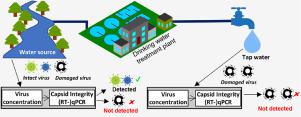Water Research ( IF 12.8 ) Pub Date : 2020-11-24 , DOI: 10.1016/j.watres.2020.116674 Vu Duc Canh , Shotaro Torii , Hiroaki Furumai , Hiroyuki Katayama

|
Capsid integrity (RT-)qPCR has recently been developed to discriminate between intact forms from inactivated forms of viruses, but its applicability to identifying integrity of viruses in drinking water has remained limited. In this study, we investigated the application of capsid integrity (RT-)qPCR using cis-dichlorodiammineplatinum (CDDP) with sodium deoxycholate (SD) pretreatment (SD-CDDP-(RT-)qPCR) to detect intact viruses in surface water and tap water. A total of 63 water samples (surface water, n = 20; tap water, n = 43) were collected and quantified by conventional (RT)-qPCR and SD-CDDP-(RT-)qPCR for pepper mild mottle virus (PMMoV) and seven other viruses pathogenic to humans (Aichivirus (AiV), noroviruses of genotypes I and II, enterovirus, adenovirus type 40 and 41, and JC and BK polyomaviruses). In surface water, PMMoV (100%) was more frequently detected than other human pathogenic viruses (30%–60%), as determined by conventional (RT-)qPCR. SD-CDDP-(RT-)qPCR also revealed that intact PMMoV (95%) was more common than intact human pathogenic viruses (20%–45%). In the tap water samples, most of the target viruses were not detected by conventional (RT-)qPCR, except for PMMoV (9%) and AiV (5%). PMMoV remained positive (5%), whereas no AiV was detected when tested by SD-CDDP-(RT-)qPCR, indicating that some PMMoV had an intact capsid, whereas AiV had damaged capsids. The presence of AiV in the absence of PMMoV in tap water produced from groundwater may demonstrate the limitation of PMMoV as a viral indicator in groundwater. In addition to being abundant in surface water, PMMoV was detected in tap water, including PMMoV with intact capsids. Thus, the absence of intact PMMoV may be used to guarantee the viral safety of tap water produced from surface water.
中文翻译:

衣壳完整性(RT-)qPCR在评估日本地表水和自来水中完整病毒的发生率中的应用
最近开发了衣壳完整性(RT-)qPCR来区分完整形式与灭活形式的病毒,但其在饮用水中鉴定病毒完整性的适用性仍然受到限制。在这项研究中,我们调查了衣壳完整性(RT-)qPCR使用顺式二氯二氨铂(CDDP)和脱氧胆酸钠(SD)预处理(SD-CDDP-(RT-)qPCR)在检测地表水和自来水中完整病毒的应用水。总共收集了63个水样本(地表水,n = 20;自来水,n = 43),并通过常规(RT)-qPCR和SD-CDDP-(RT-)qPCR定量分析了胡椒轻斑驳病毒(PMMoV)以及其他七种对人类有致病性的病毒(爱知病毒(AiV),基因型I和II的诺如病毒,肠病毒,40和41型腺病毒以及JC和BK多瘤病毒)。在地表水中 通过常规(RT-)qPCR确定,PMMoV(100%)比其他人类致病病毒(30%–60%)检出率更高。SD-CDDP-(RT-)qPCR还显示完整的PMMoV(95%)比完整的人类致病病毒(20%–45%)更常见。在自来水样品中,除PMMoV(9%)和AiV(5%)外,大多数目标病毒都无法通过常规(RT-)qPCR检测到。PMMoV保持阳性(5%),而通过SD-CDDP-(RT-)qPCR检测时未检测到AiV,这表明某些PMMoV具有完整的衣壳,而AiV的衣壳已损坏。在地下水产生的自来水中不存在PMMoV的情况下,存在AiV可能表明PMMoV作为地下水中的病毒指示剂存在局限性。除了地表水丰富以外,还检测了自来水中的PMMoV,包括衣壳完整的PMMoV。从而,

























 京公网安备 11010802027423号
京公网安备 11010802027423号